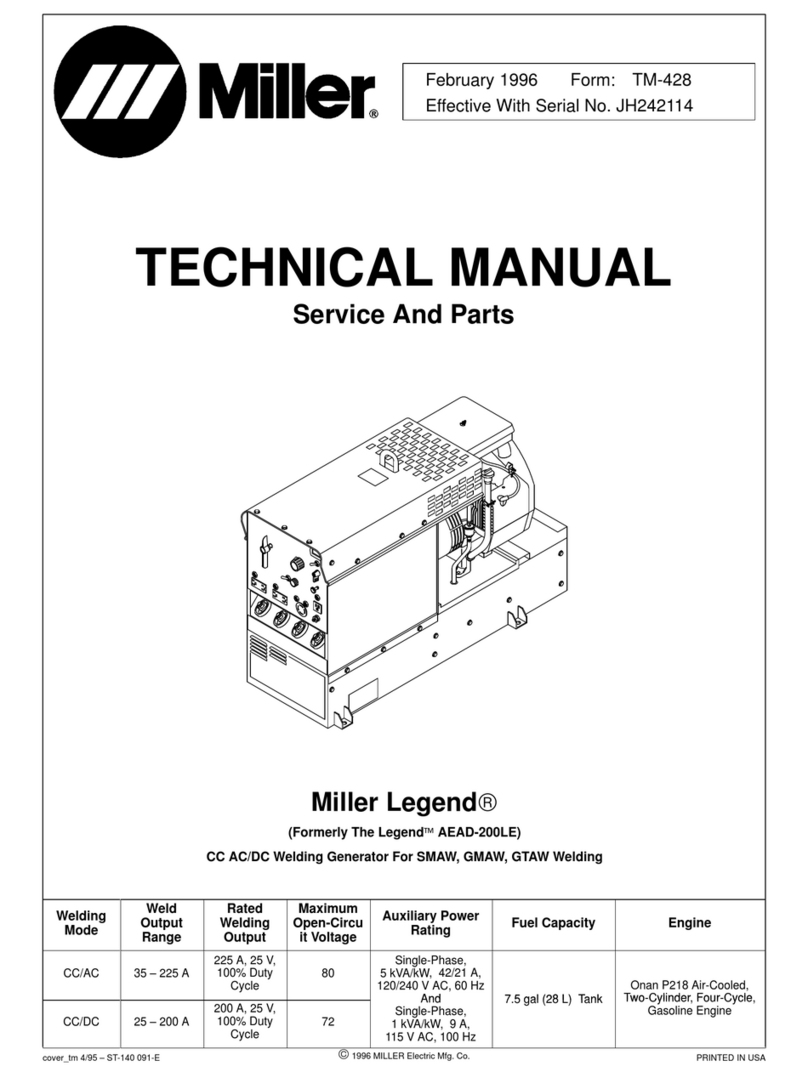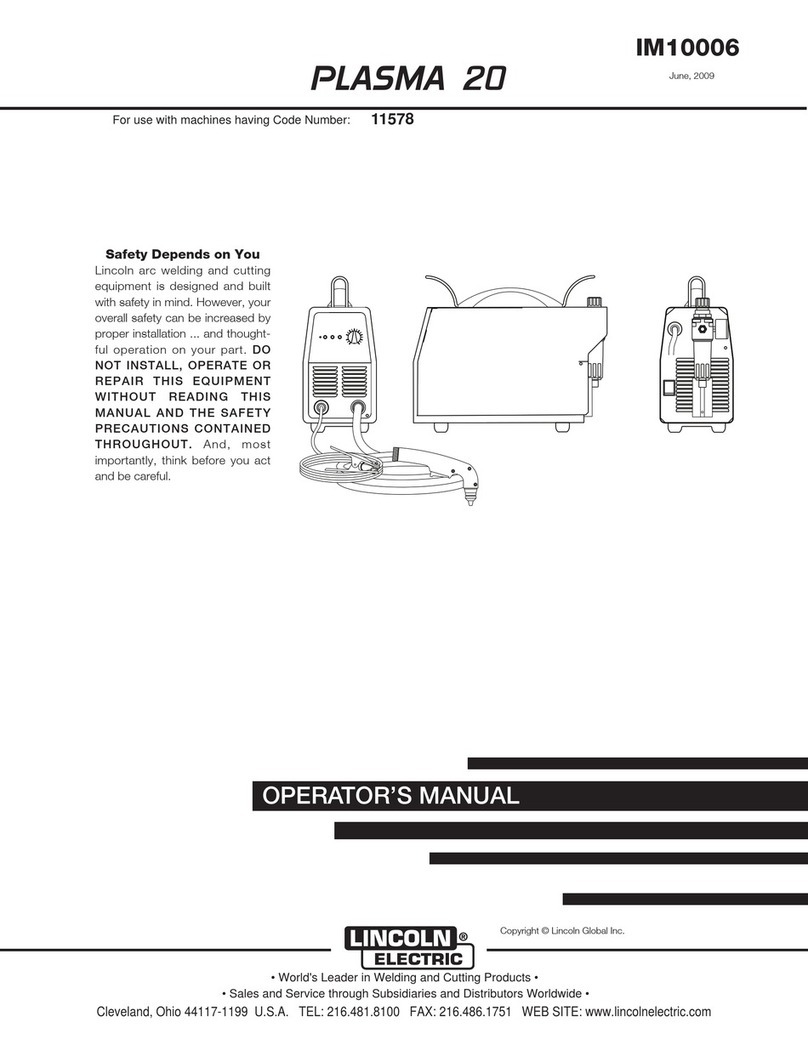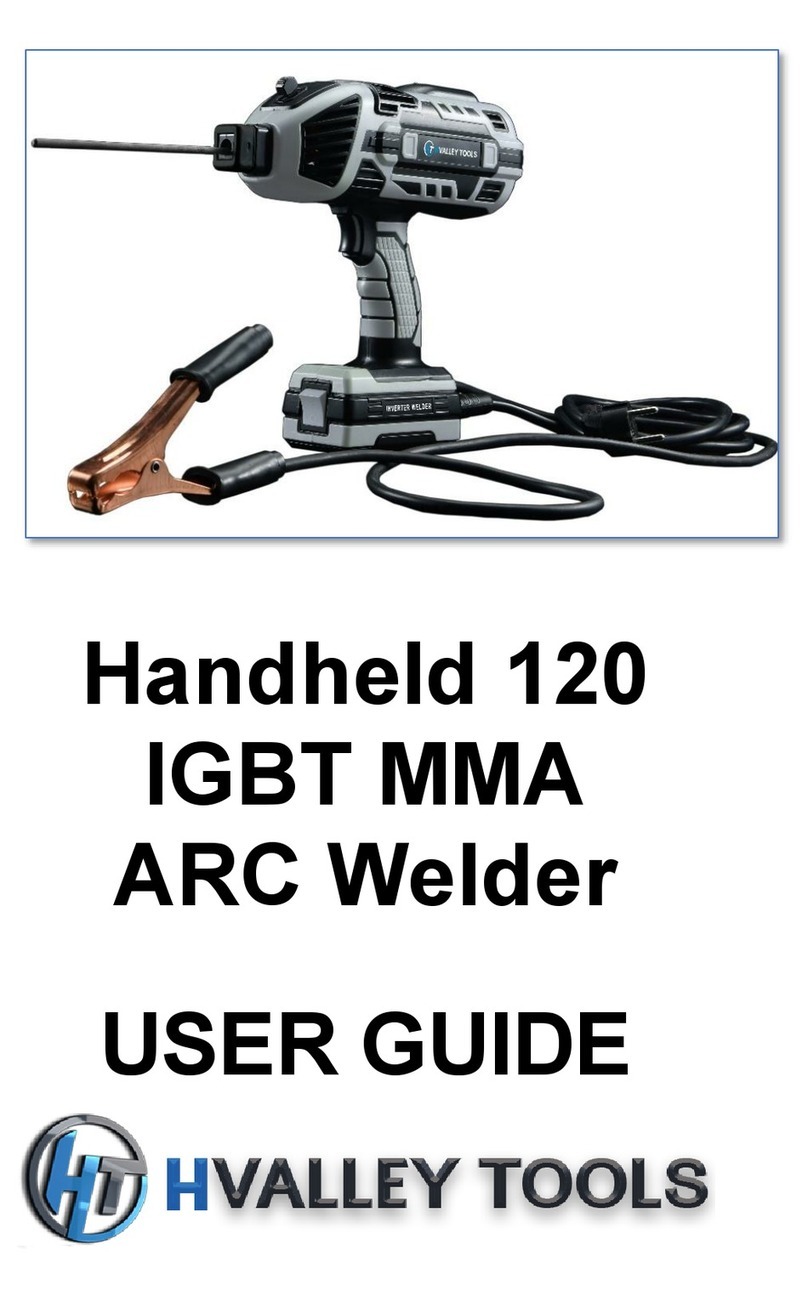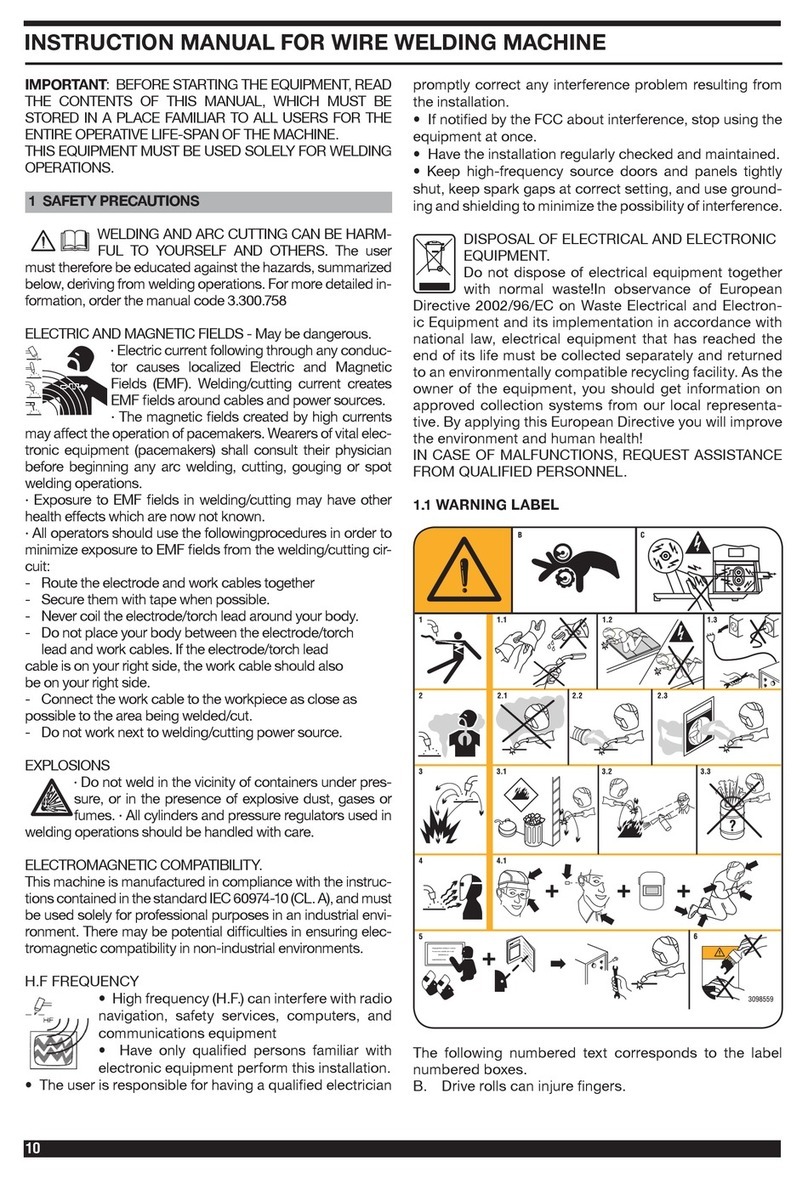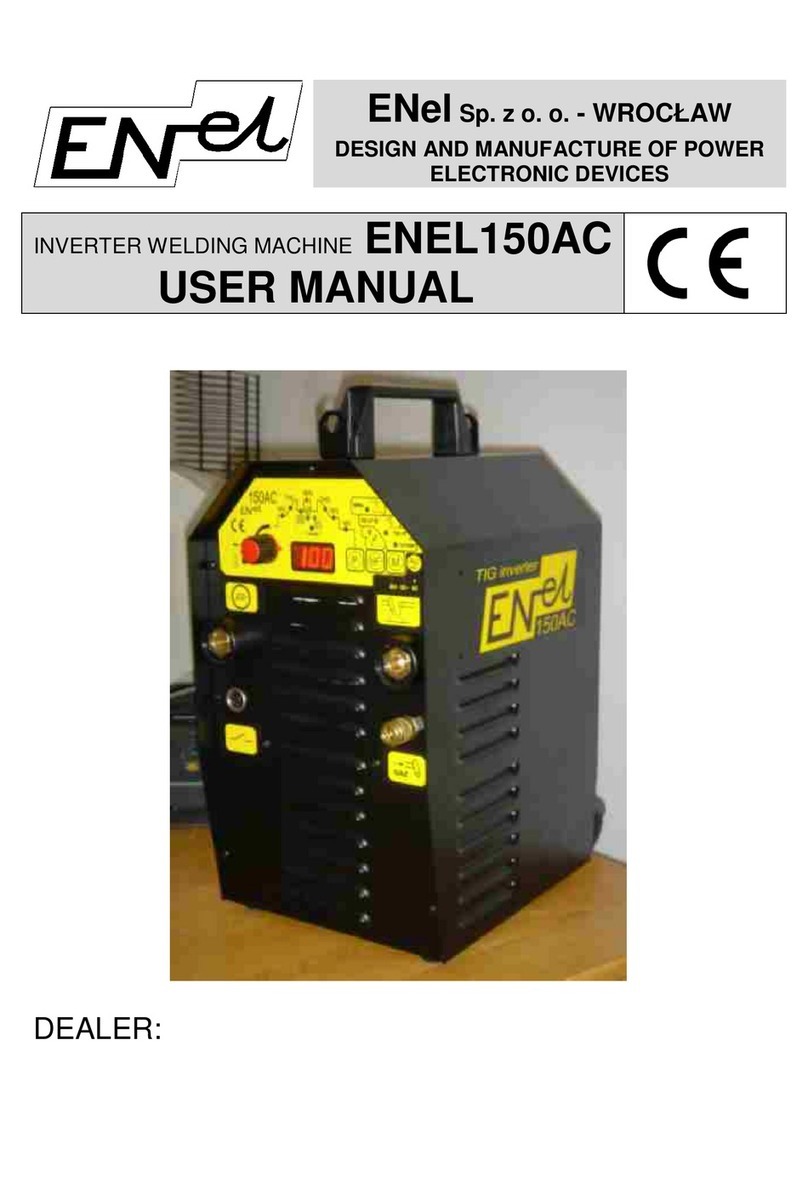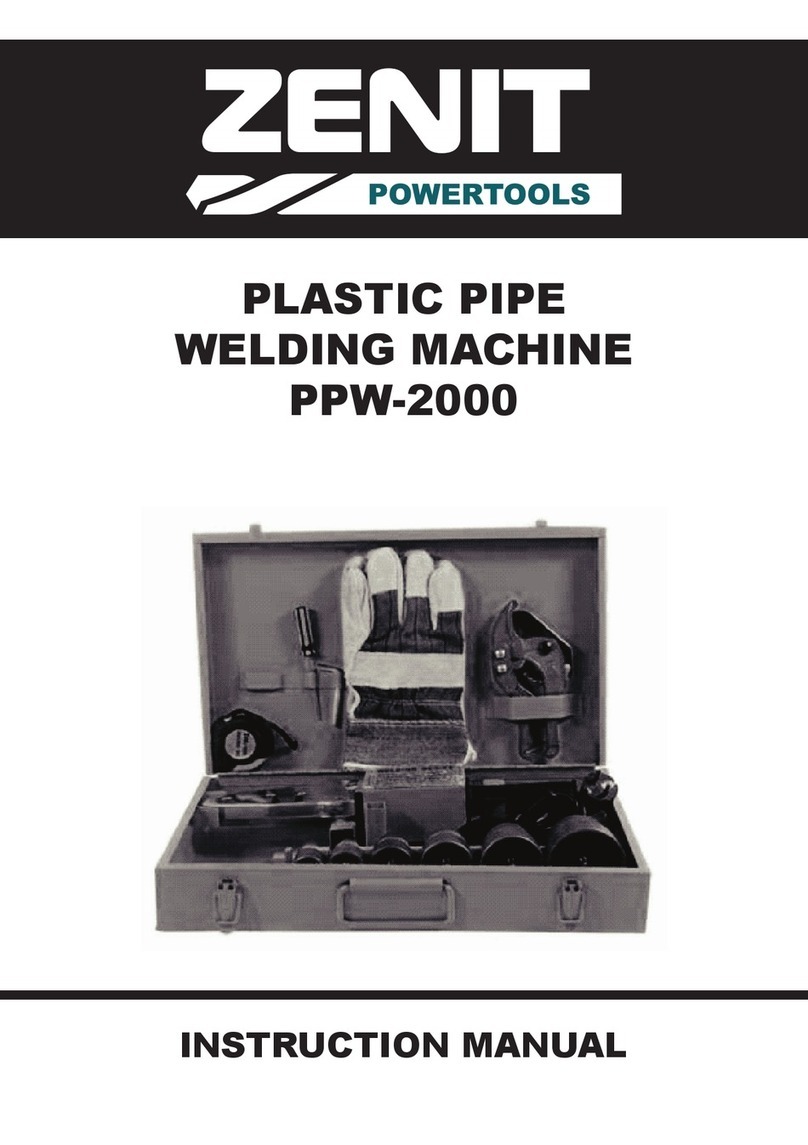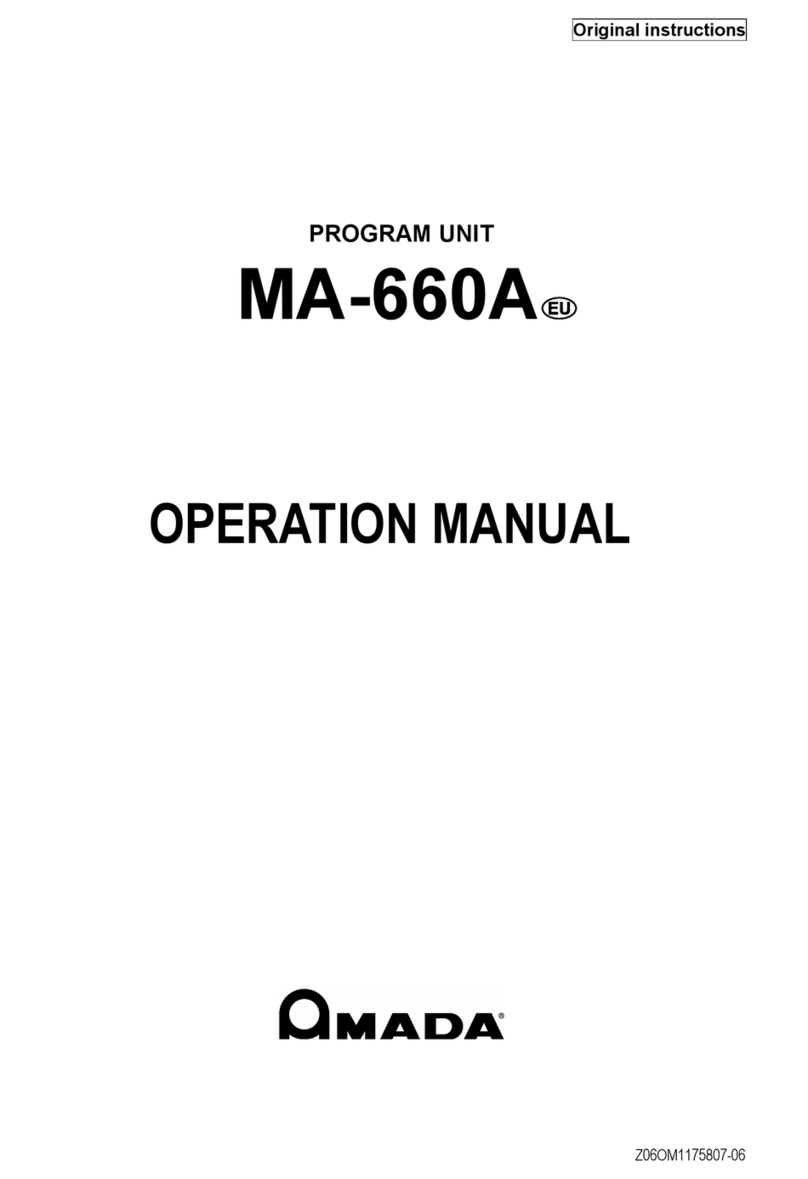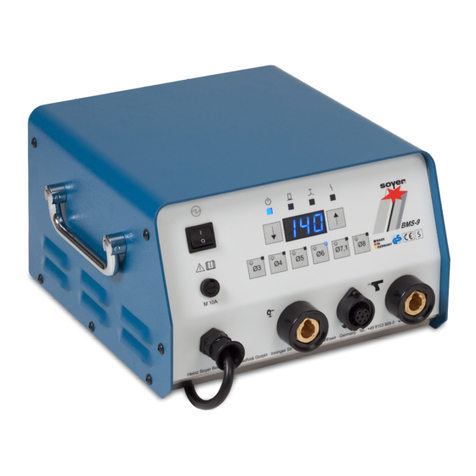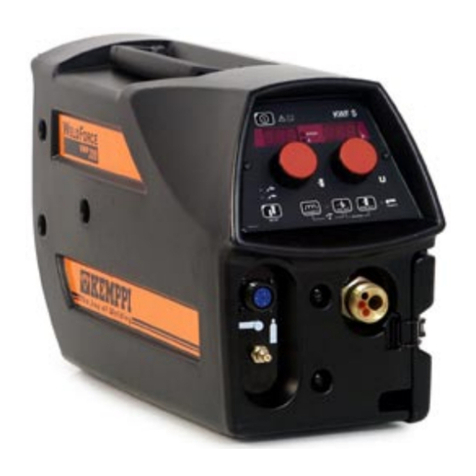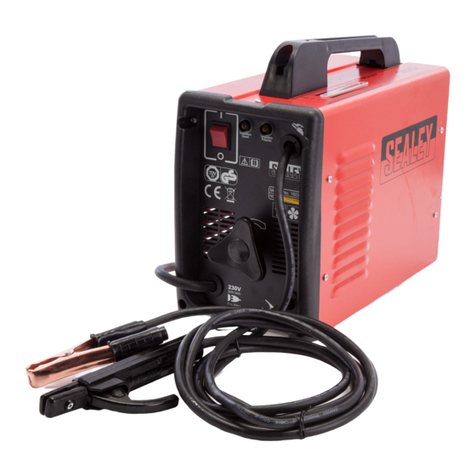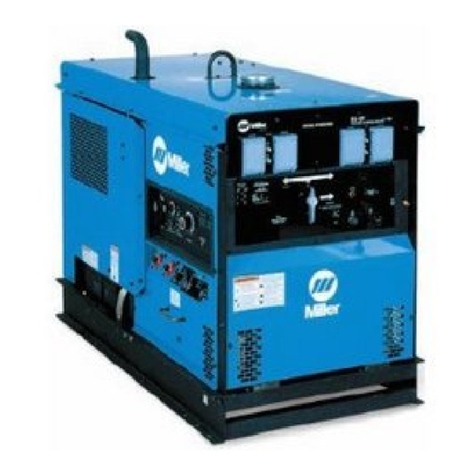MIG-TIG-STICK KUMJR250 User manual

1
240 Volt
Standard
MIG / MAG
Lift Arc DC/TIG
Plasma CUT
Standard
MIG / MAG
Lift Arc DC/TIG
Plasma CUT
Standard
MIG / MAG
Lift Arc DC/TIG
Plasma CUT
YEARS Warranty
(Power Source)
3
ADVANTAGE
MIG-TIG-STICK BUILT-IN
MIG-TIG-STICK
TECHNOLOGY
ADVANTAGE
TECHNOLOGY
TECHNOLOGY
MIG-TIG-STICK BUILT-IN
TECHNOLOGY
MIG-TIG-STICK
TECHNOLOGY
Please read and understand this instruction manual carefully
before the installation and operation of this equipment.
OPERATING MANUAL
KUMJR250
©Welding Guns Of Australia PTY LTD 2012

2
Thank you for your purchase of your UNI-MIG welding machine.
We are proud of our range of welding equipment that has a proven track record of innovation,
performance and reliability.
Our product range represents the latest developments in Inverter technology put together by our
professional team of highly skilled engineers. The expertise gained from our long involvement with
inverter technology has proven to be invaluable towards the evolution and future development of
our equipment range. This experience gives us the inside knowledge on what the arc
characteristics, performance and interface between man and machine should be.
Within our team are specialist welders that have a proven history of welding knowledge and
expertise, giving vital input towards ensuring that our machines deliver control and performance to
the utmost professional level.
We employ an expert team of professional sales, marketing and technical personnel that provide
us with market trends, market feedback and customer comments and requirements. Secondly they
provide a customer support service that is second to none, thus ensuring our customers have
condence that they will be well satised both now and in the future.
UNI-MIG welders are manufactured and compliant with - AS/NZ60974.1 2006 - AS60974-6:2006
guaranteeing you electrical safety and performance.
WARRANTY
• 3 Years from date of purchase.
• Welding Guns Of Australia PTY LTD Ltd warranties all goods as specified by the manufacturer
of those goods.
• This Warranty does not cover freight or goods that have been interfered with.
• All goods in question must be repaired by an authorised repair agent as appointed by this
company.
• Warranty does not cover abuse, mis-use, accident, theft, general wear and tear.
• New product will not be supplied unless Welding Guns Of Australia PTY LTD has inspected
product returned for warranty and agree’s to replace product.
• Product will only be replaced if repair is not possible
• Please view full Warranty term and conditions supplied with machine or at www.unimig.com.au/
warranty.asp or at the back of this manual.

3
CONTENTS PAGE
Warranty 2
Technical Data, Product Information 4
Safety - Cautions 5-7
Machine Layout Pictogram 8
Installation Operation Cautions 9
Installation & Operation for MMA (stick) Welding 10
MMA (Stick) Welding Information 11-12
Installation & Operation for MIG Welding with Gas 13-14
Wire Feed Drive Roller Selection 16
Wire Installation Set up Guide 16
Installation & Operation for MIG Welding with No Gas 17-18
Installation Guide for Mig Torch Liner Installation 19
Mig Torch and Wire Feeder Set Up Guide for Aluminium Mig Wire 20-21
Installation & Operation for MIG Welding with Spool Gun 22-23
MIG (Metal Inert Gas) Welding 24-25
Basic MIG Welding Guide 26-29
Installation & Operation for DC TIG Welding with Lift Arc 30-31
DC TIG Welding 32-33
Tungsten Electrodes 34-35
24 MIG Torch Parts Breakdown 36-37
SP200 Spool Gun Torch Parts Breakdown 38-39
17VTIG Torch Parts Breakdown 40-41
Mig Welding Shooting Guide 42-43
TIG Welding Shooting Guide 44-45
MMA Welding Trouble Shooting Guide 46
Machine Spare Parts Breakdown 47
Warranty 48-50

4
MIG/MMA/TIG - 250 Amp DC Welding Machine Lightweight & Portable
Welds: Steels, Stainless, Cast Iron, Bronze, Aluminium, Copper
Technical Data
Power Supply / Phases (V-Ph) 240v - 1 +/- 15%
Duty Cycle @ 40°c as per AS/NZ60974 40% @ 250 Amps MIG
40% @ 224 Amps MMA
Duty Cycle @ 25°c (approximate) 70% @ 250 Amps MIG
70% @ 224Amps MMA
Output Current Range MIG 30A/15.5V - 250A/26.5V
Output Current Range MMA 10A/20.4V - 350A/33.0V
Rated Power MIG 10.8 KVA
I Max MIG 45 Amps
MMA 51 Amps
I
i
eff MIG 26.6 Amps
MMA 28 0 Amps
Power factor 0.72
Protection Class P 21S
Insulation Class F
Wire Feeder Type Gear Driven 2 Roll
Wire Diameter Range (mm) 0.6, 0.8, 0.9, 1.0, 1.2
Dimensions Power Source (LxWxH) 585x280x440mm
Weight Power Source 35 Kg
Dimensions Trolley (LxWxH) 880x430x410mm
Warranty 2 years on machine
Features
• LatestIGBTinvertertechnology
• Mig/MagwithGasandGaslesswirefunction
• Stickelectrode(MMA)function
• DCTigweldingwithLiftArcStart
• Industrialapplication
• Optionaltrolley
• Internalwirefeeder,geardrivenforupto300mmØspool
• Euromigtorchconnection
• IP21Sratingforenvironmental/safetyprotection
• Toleranttovariablepowersupply
• Seamlessvoltageandwirefeedcontrol
• ExcellentmigweldingwithCO2gas
• Excellentarcstabilitywithallelectrodes
• Lightweightandportable
KUMJR250
Overview
The UNI-MIG250 is a new inverter-based portable Mig welding machine with added MMA and Tig function. The Mig
function allows you to weld with both Gas Shielded and Gas-less wire applications. Easy step less adjustment of voltage and
wire feed make for easy setting of welding parameters giving excellent, professional welding results. Wire inch gives easy
feeding of the wire during set up without gas wastage and the Burn Back adjustment leaves the wire stick out ready for the next
weld. MMA welding capability delivers easy electrode welding with high quality results, including cast Iron, stainless and low
hydrogen. Connection of the 17V tig torch provides quality DC Tig with Lift Arc start for welding of steel, stainless steel and
copper. An additional feature is the Spoolgun ready function that allows the simple connection of the SPG200 Spoolgun for the
use of thin or softer wires that don’t have the column strength to feed through standard mig torches, such as aluminium wire.
This an industrial machine that is lightweight and portable, an optional trolley with drawer and cylinder rack provides off the
floor operation and better manoeuvrability around the workshop. Being 240v single phase gives great portability. Ideal for
general engineers, maintenance workshop, rural workshop, panel beaters, home workshop. Designed and built to our
specification. Certified to - AS/NZ60974.1
YEARS Warranty
(Power Source)
2
MACHINE PACKAGE: KUMJR250
UNI-MIG 250 Multifunction Welding Inverter / SB24 4M Xcel-Arc Sure Grip MIG torch with Euro connector
4M ARC lead set 35/50mm Dinse style connections / UNI-FLAME Twin Gauge Argon Regulator
2M Gas Hose Complete with fittings
MULTIFUNCTION INVERTER OPTIONS
17V TIG WELDING TORCH
Part No: 17V4MCP35/50
MACHINE TROLLEY
Part No: UMJRTROLLEY2
SPOOL GUN
Part No: SPG200

5
SAFETY
Welding and cutting equipment can be dangerous to both the operator and people in or near the
surrounding working area, if the equipment is not correctly operated. Equipment must only be
used under the strict and comprehensive observance of all relevant safety regulations.
Read and understand this instruction manual carefully before the installation and operation of this
equipment.
• Do not switch the function modes while the machine is operating. Switching of the function modes during
welding can damage the machine. Damage caused in this manner will not be covered under warranty.
• Disconnect the electrode-holder cable from the machine before switching on the machine, to avoid arcing
should the electrode be in contact with the work piece.
• Operators should be trained and or qualied.
Electric shock: It can kill. Touching live electrical parts can cause fatal shocks or severe
burns. The electrode and work circuit is electrically live whenever the output is on. The input
power circuit and internal machine circuits are also live when power is on. In Mig/Mag welding,
the wire, drive rollers, wire feed housing, and all metal parts touching the welding wire are
electrically live. Incorrectly installed or improperly grounded equipment is dangerous.
• Connect the primary input cable according to Australian and New Zealand standards and regulations.
• Avoid all contact with live electrical parts of the welding circuit, electrodes and wires with bare hands.
The operator must wear dry welding gloves while he/she performs the welding task.
• The operator should keep the work piece insulated from himself/herself.
• Keep cords dry, free of oil and grease, and protected from hot metal and sparks.
•Frequently inspect input power cable for wear and tear, replace the cable immediately if damaged,
bare wiring is dangerous and can kill.
•Do not use damaged, under sized, or badly joined cables.
•Do not drape cables over your body.
• We recommend (RCD) safety switch is used with this equipment to detect any leakage of current to earth.
Fumes and gases are dangerous. Smoke and gas generated whilst welding or cutting can
be harmful to people’s health. Welding produces fumes and gases. Breathing these fumes and
gases can be hazardous to your health.
•Do not breathe the smoke and gas generated whilst welding or cutting, keep your head out of the fumes
• Keep the working area well ventilated, use fume extraction or ventilation to remove welding fumes and
gases.
• In conned or heavy fume environments always wear an approved air-supplied respirator.
Welding fumes and gases can displace air and lower the oxygen level causing injury or death. Be sure the
breathing air is safe.
• Do not weld in locations near de-greasing, cleaning, or spraying operations. The heat and rays of the arc
can react with vapours to form highly toxic and irritating gases.
• Materials such as galvanized, lead, or cadmium plated steel, containing elements that can give off toxic
fumes when welded. Do not weld these materials unless the area is very well ventilated, and or wearing
an air supplied respirator.
Arc rays: harmful to people’s eyes and skin. Arc rays from the welding process produce
intense visible and invisible ultraviolet and infrared rays that can burn eyes and skin.
•Always wear a welding helmet with correct shade of lter lens and suitable protective clothing including
welding gloves whilst the welding operation is performed.
•Measures should be taken to protect people in or near the surrounding working area. Use protective
screens or barriers to protect others from ash,glare and sparks; warn others not to watch the arc.
Machine Operating Safety
Technical Data
Power Supply / Phases (V-Ph) 240v - 1 +/- 15%
Duty Cycle @ 40°c as per AS/NZ60974 40% @ 250 Amps MIG
40% @ 224 Amps MMA
Duty Cycle @ 25°c (approximate) 70% @ 250 Amps MIG
70% @ 224Amps MMA
Output Current Range MIG 30A/15.5V - 250A/26.5V
Output Current Range MMA 10A/20.4V - 350A/33.0V
Rated Power MIG 10.8 KVA
I Max MIG 45 Amps
MMA 51 Amps
I
i
eff MIG 26.6 Amps
MMA 28 0 Amps
Power factor 0.72
Protection Class P 21S
Insulation Class F
Wire Feeder Type Gear Driven 2 Roll
Wire Diameter Range (mm) 0.6, 0.8, 0.9, 1.0, 1.2
Dimensions Power Source (LxWxH) 585x280x440mm
Weight Power Source 35 Kg
Dimensions Trolley (LxWxH) 880x430x410mm
Warranty 2 years on machine

6
Fire hazard. Welding on closed containers, such as tanks,drums, or pipes, can cause them
to explode. Flying sparks from the welding arc, hot work piece, and hot equipment can cause
res and burns. Accidental contact of electrode to metal objects can cause sparks, explosion,
overheating, or re. Check and be sure the area is safe before doing any welding.
•The welding sparks & spatter may cause re, therefore remove any ammable materials well away from
the working area. Cover ammable materials and containers with approved covers if unable to be moved
from the welding area.
•Do not weld on closed containers such as tanks, drums, or pipes, unless they are properly prepared
according to the required Safety Standards to insure that ammable or toxic vapors and substances are
totally removed, these can cause an explosion even though the vessel has been “cleaned”.
Vent hollow castings or containers before heating, cutting or welding. They may explode.
• Do not weld where the atmosphere may contain ammable dust, gas, or liquid vapours (such as petrol)
•Have a re extinguisher nearby and know how to use it. Be alert that welding sparks and hot materials
from welding can easily go through small cracks and openings to adjacent areas. Be aware that welding
on a ceiling, oor, bulkhead, or partition can cause re on the hidden side.
Gas Cylinders. Shielding gas cylinders contain gas under high pressure. If damaged, a cylin-
der can explode. Because gas cylinders are normally part of the welding process, be sure to
treat them carefully. CYLINDERS can explode if damaged.
• Protect gas cylinders from excessive heat, mechanical shocks, physical damage, slag, open ames,
sparks, and arcs.
•Insure cylinders are held secure and upright to prevent tipping or falling over.
•Never allow the welding electrode or earth clamp to touch the gas cylinder, do not drape welding cables
over the cylinder.
•Never weld on a pressurised gas cylinder, it will explode and kill you.
•Open the cylinder valve slowly and turn your face away from the cylinder outlet valve and gas regulator.
Gas build up. The build up of gas can causes a toxic environment, deplete the oxygen content
in the air resulting in death or injury. Many gases use in welding are invisible and odourless.
•Shut off shielding gas supply when not in use.
• Always ventilate conned spaces or use approved air-supplied respirator.
Electronic magnetic elds. MAGNETIC FIELDS can affect Implanted Medical Devices.
•Wearers of Pacemakers and other Implanted Medical Devices should keep away.
•Implanted Medical Device wearers should consult their doctor and the device manufacturer before going
near any electric welding, cutting or heating operation.
Noise can damage hearing. Noise from some processes or equipment can damage hearing.
Wear approved ear protection if noise level is high.
Hot parts. Items being welded generate and hold high heat and can cause severe burns.
Do not touch hot parts with bare hands. Allow a cooling period before working on the welding
gun. Use insulated welding gloves and clothing to handle hot parts and prevent burns.

7
CAUTION
1. Working Environment.
1.1 The environment in which this welding equipment is installed must be free of grinding dust, corrosive
chemicals, ammable gas or materials etc, and at no more than maximum of 80% humidity.
1.2 When using the machine outdoors protect the machine from direct sun light, rain water and snow etc;
the temperature of working environment should be maintained within -10°C to +40°C.
1.3 Keep this equipment 30cm distant from the wall.
1.4 Ensure the working environment is well ventilated.
2. Safety Tips.
2.1 Ventilation
This equipment is small-sized, compact in structure, and of excellent performance in amperage output.
The fan is used to dissipate heat generated by this equipment during the welding operation.
Important: Maintain good ventilation of the louvers of this equipment. The minimum distance between
this equipment and any other objects in or near the working area should be 30 cm. Good ventilation is
of critical importance for the normal performance and service life of this equipment.
2.2 Thermal Overload protection.
Should the machine be used to an excessive level, or in high temperature environment, poorly
ventilated area or if the fan malfunctions the Thermal Overload Switch will be activated and the
machine will cease to operate. Under this circumstance, leave the machine switched on to keep the
built-in fan working to bring down the temperature inside the equipment. The machine will be ready for
use again when the internal temperature reaches safe level.
2.3 Over-Voltage Supply
Regarding the power supply voltage range of the machine, please refer to “Main parameter” table.
This equipment is of automatic voltage compensation, which enables the maintaining of the voltage
range within the given range. In case that the voltage of input power supply amperage exceeds the
stipulated value, it is possible to cause damage to the components of this equipment. Please ensure
your primary power supply is correct.
2.4 Do not come into contact with the output terminals while the machine is in operation. An electric shock
may possibly occur.
MAINTENANCE
Exposure to extremely dusty, damp, or corrosive air is damaging to the welding machine. In order to pre-
vent any possible failure or fault of this welding equipment, clean the dust at regular intervals with clean and
dry compressed air of required pressure.
Please note that: lack of maintenance can result in the cancellation of the guarantee; the guarantee of
this welding equipment will be void if the machine has been modied, attempt to take apart the machine or
open the factory-made sealing of the machine without the consent of an authorized representative of the
manufacturer.
TROUBLE SHOOTING
Caution: Only qualied technicians are authorized to undertake the repair of this welding equipment.
For your safety and to avoid Electrical Shock, please observe all safety notes and precautions
detailed in this manual.
Note:
Minimum Motor Generator Power Suggested:- 5.5KVA for Mig175 - 7KVA for MIG190

8
FRONT PANEL LAYOUT
1. Amperage Meter
2. Voltage Meter
3. VRD LED
4. Wire Inch Button
5. Mig/MMA/Tig Mode Selector Switch
6. Wire Feed Adjustment Knob (MIG/MAG)
7. Standard Mig / Spoolgun Selector Switch
8. “-” Output terminal
9. SpoolGun Power Supply Connection
10. “+” Output terminal
11. Euro Mig Torch Connector (MIG/MAG)
12. Voltage Adjustment Knob (MIG/MAG)
13. Amperage Adjustment Knob (MMA/TIG)
14. Thermal Overload LED
15. Mains Power LED
1 2 3 4 5
15
14
13
12
6
7
8
9
10
11
BACK PANEL LAYOUT
16. Input power cable
17. Power switch
18. Fan
19. Gas Inlet
20. Data Plate
19
16
17
18
20
INTERNAL PANEL LAYOUT
20. DC Positive output terminal
21. DC Negative output terminal
22. Burn back control
23. Spool holder assembly
24. Wire feeder mechanism
20 21 22
2324

9
INSTALLATION & OPERATION
Please install the machine strictly according to the following steps.
The protection class of this machine is IP21S, so avoid using it in rain.
Connection of Input Cables
Primary input cable is supplied with this welding equipment. Connect the primary input cable with power
supply of required input voltage. Refer to data plate on machine for Input voltage, IMAX and IEFF.
Before MMA (Stick)Welding:
Disconnect the cable with twist lock connector
that is attached to the wire feeder from the output
socket’s “GAS” “NO-GAS” on the backboard.
If cable is not disconnected welding voltage is
present on MIG torch and can cause arcing or
ash.
WARNING!

10
Installation set up for MMA (Stick) Welding with UNI-MIG MIG250 MTS
(1) Turn the power source on and select the MMA function with the Tig/MMA/Mig selector switch.
(2) Connection of Output Cables
Two sockets are available on this welding machine. For MMA welding the electrode holder is shown
connected to the positive socket, while the earth lead (work piece) is connected to the negative
socket, this is known as DC+ polarity. However various electrodes require a different polarity for
optimum results and careful attention should be paid to the polarity, refer to the electrode
manufacturers information for the correct polarity.
DC+ Electrode connected to output socket.
DC- Electrode connected to output socket.
(3) Set the welding current relevant to the electrode type and size being used as recommended by the
electrode manufacturer.
(2) Connect earth
lead to
(1) Set Tig/MMA/Mig selector
switch to MMA
(2) Connect the electrode
lead to
(3) Set the welding current using the amperage
control dial.
(6) Hold the electrode slightly above the work
maintaining the arc while travelling at an even
speed.
(4) Place the electrode into the electrode holder
and clamp tight.
(7) To nish the weld, break the arc by quickly
snapping the electrode away from the work
piece.
(5) Strike the electrode against the workpiece to
create an arc and hold the electrode steady to
maintain the arc.
(8) Wait for the weld to cool and carefully chip
away the slag to reveal the weld metal below.

11
MMA (Manual Metal Arc) Welding
One of the most common types of arc welding is manual metal arc welding (MMA) or stick welding. An electric cur-
rent is used to strike an arc between the base material and a consumable electrode rod or ‘stick’. The electrode rod
is made of a material that is compatible with the base material being welded and is covered with a ux that gives off
gaseous vapours that serve as a shielding gas and providing a layer of slag, both of which protect the weld area from
atmospheric contamination. The electrode core itself acts as ller material the residue from the ux that forms a slag
covering over the weld metal must be chipped away after welding.
Core wire
Flux coating
Gas shield from ux melt
Arc with core wire melt
Flux residue forms slag cover
Weld metal
Power Source
+
▬
• The arc is initiated by momentarily touching the electrode to the base metal.
• The heat of the arc melts the surface of the base metal to form a molten pool
at the end of the electrode.
• The melted electrode metal is transferred across the arc into the molten pool
and becomes the deposited weld metal.
• The deposit is covered and protected by a slag which comes from the
electrode coating.
• The arc and the immediate area are enveloped by an atmosphere of
protective gas
Core wire
Flux coating
Base metal
Protective gas
Arc
Slag
Weld pool
Manual metal arc ( stick) electrodes have a solid metal wire core and a ux
coating. These electrodes are identied by the wire diameter and by
a series of letters and numbers. The letters and numbers identify the metal
alloy and the intended use of the electrode.
The Metal Wire Core works as conductor of the current that maintains the arc.
The core wire melts and is deposited into the welding pool.
The covering on a shielded metal arc welding electrode is called Flux.
The ux on the electrode performs many different functions.
These include:
● producing a protective gas around the weld area
● providing uxing elements and deoxidizers
●creating a protective slag coating over the weld as it cools
●establishing arc characteristics
●adding alloying elements.
Covered electrodes serve many purposes in addition to adding ller metal to
the molten pool. These additional functions are provided mainly by the cover-
ing on the electrode.

12
Electrode Size
Average Thickness Maximum Recommended
of Material Electrode Diameter
1.0 - 2.0mm 2.5mm
2.0 - 5.0mm 3.2mm
5.0 - 8.0mm 4.0mm
8.0 - > mm 5.0mm
The size of the electrode generally depends on the
thickness of the section being welded, and the thicker
the section the larger the electrode required. The table
gives the maximum size of electrodes that maybe used
for various thicknesses of section based on using a
general purpose type 6013 electrode.
Correct current selection for a particular job is an
important factor in arc welding. With the current set too
low, difculty is experienced in striking and maintaining
a stable arc. The electrode tends to stick to the work,
penetration is poor and beads with a distinct rounded
prole will be deposited. Too high current is
accompanied by overheating of the electrode resulting
undercut and burning through of the base metal and
producing excessive spatter. Normal current for a particular job may be considered as the maximum, which
can be used without burning through the work, over-heating the electrode or producing a rough spattered
surface.The table shows current ranges generally recommended for a general purpose type 6013
electrode.
Arc Length
To strike the arc, the electrode should be gently scraped on the work until the arc is established. There is a
simple rule for the proper arc length; it should be the shortest arc that gives a good surface to the weld. An
arc too long reduces penetration, produces spatter and gives a rough surface nish to the weld.
An excessively short arc will cause sticking of the electrode and result in poor quality welds. General rule of
thumb for down hand welding is to have an arc length no greater than the diameter of the core wire.
Electrode Angle
The angle that the electrode makes with the work is important to ensure a smooth, even transfer of metal.
When welding in down hand, llet, horizontal or overhead the angle of the electrode is generally between 5
and 15 degrees towards the direction of travel. When vertical up welding the angle of the electrode should
be between 80 and 90 degrees to the work piece.
Travel Speed
The electrode should be moved along in the direction of the joint being welded at a speed that will give the
size of run required. At the same time, the electrode is fed downwards to keep the correct arc length at all
times. Excessive travel speeds lead to poor fusion, lack of penetration etc, while too slow a rate of travel
will frequently lead to arc instability,slag inclusions and poor mechanical properties.
Material and Joint Preparation
The material to be welded should be clean and free of any moisture, paint, oil, grease, mill scale, rust or
any other material that will hinder the arc and contaminate the weld material. Joint preparation will depend
on the method used include sawing, punching, shearing, machining, ame cutting and others. In all cases
edges should be clean and free of any contaminates. The type of joint will be determined by the chosen
application.
Welding Current (Amperage)
Electrode Size Current Range
ø mm (Amps)
2.5mm 60 - 100
3.2mm 100 - 130
4.0mm 130 - 165
5.0mm 165 - 260
Electrode Selection
As a general rule, the selection of an electrode is straight forward,in that it is only a matter of selecting an
electrode of similar composition to the parent metal. However, for some metals there is a choice of several
electrodes, each of which has particular properties to suit specic classes of work. It is recommend to
consult your welding supplier for the correct selection of electrode.
MMA (Stick) Welding Fundamentals

13
Installation set up for MIG with Gas for UNI-MIG MIG250 MTS
(1) Select the MIG function with the Tig/MMA/Mig selector switch.
(2) Select Standard using the Standard/Spool Gun selector switch.
(3) Plug the welding torch into the Euro Mig torch connection socket on the front panel, and tighten it.
IMPORTANT : When connecting the torch be sure to tighten the connection. A loose connection can
result in the connector arcing and damaging the machine and gun connector.
This damage is not covered under warranty.
(4) Insert the earth cable plug into the negative socket on the front of the machine and tighten it.
(5) Connect Gas Line to Gas Regulator and connect the gas regulator to the Gas Cylinder.
(6) Connect the weld power cable plug inside the wire feeder to the output socket GAS, and tighten it.
(7) Place the Wire Spool onto the Spool Holder - Note: the spool retaining nut is Left Hand thread.
Snip the wire from the spool being sure to hold the wire to prevent rapid uncoiling. Feed the wire into
the wire feeder inlet guide tube through to the drive roller.
(8) Carefully feed the wire over the drive roller into the outlet guide tube, feed through about 150mm into
the torch receptacle. Check that the drive roller being used complies with the wire diameter, replace the
roller if necessary.
Caution:
Disconnect the Electrode Holder cable from the machine before using MIG function. If cable is not disconnected welding
voltage is present and can cause arcing or ash.
(7) Place wire onto spool holder - (spool
retaining nut is left hand thread ) Feed the wire
through the inlet guide tube on to the drive
roller.
(6) Connect weld power lead to GAS (8) Feed wire over the drive roller into the outlet
guide tube, Push the wire through approx
150mm.
(2) Set Standard/Spoolgun
selector switch to Standard
(3) Connect Mig torch
(5) Connect the gas line to the regulator
and connect to the gas cylinder
(1) Set Tig/MMA/Mig selector
switch to Mig
IMPORTANT : When connecting the torch
besuretotightentheconnection.
(4) Connect earth lead to
Note: Pictures may vary from your model machine

14
Continued set up for MIG with Gas for UNI-MIG MIG250 MTS
(9) Align the wire into the groove of the drive roller and close down the top roller making sure the wire is in
the groove of the bottom drive roller, lock the pressure arm into place.
(10) Apply a medium amount of pressure to the drive roller.
(11) Remove the gas nozzle and contact tip from the torch neck,
(12) Press and hold the inch button to feed the wire through to the torch neck, release the inch button when
the wire exits the torch neck.
(13) Fit the correct sized contact tip and feed the wire through it, screw the contact tip into the tip holder of
the torch head and nip it up tightly.
(14) Fit the gas nozzle to the torch head.
(15) Carefully open the gas cylinder valve and set the ow rate to between 5-20 l/min.
(16) Set the welding parameters using the wire feed and voltage control knobs.
(17) Using the Burn Back control set the amount of wire to ‘burn back’ after you release the torch
trigger. This prevents the wire becoming stuck in the weld pool when nishing the weld.
(12) Press and hold the inch wire button to
feed the wire down the torch cable through
to the torch head.
(11) Remove the gas nozzle and contact tip
from the front end of the mig torch.
(13) Fit the correct size contact tip over
the wire and fasten tightly into the tip
holder.
(14) Fit the gas nozzle to the torch head.
(16) Set welding parameters using the
voltage and wire feed controls.
(17) Adjust the burn back control to prevent
the wire sticking in the weld pool.
(9) Close down the top roller bracket and clip
the pressure arm into place.
(10) Apply a medium amount of
pressure to the drive roller
(15) Carefully open the valve of the gas
cylinder, set the ow to 10 l/min
Note: Pictures may vary from your model machine

15
25mm
35mm
8mm
V Groove Drive Roller - Steel Wire
Part Number Description
0.6-0.8V30/22 Drive Roll V Groove 0.6-0.8mm
0.8-1.0V30/22 Drive Roll V Groove 0.8-1.0mm
0.9-1.2V30/22 Drive Roll V Groove 0.9-1.2mm
1.0-1.2V30/22 Drive Roll V Groove 1.0-1.2mm
1.2-1.6V30/22 Drive Roll V Groove 1.2-1.6mm
Knurled Drive Roller - Flux Core Wire
Part Number Description
0.6-0.8F30/22 Drive Roll Knurled 0.6-0.9mm
0.8-0.9F30/22 Drive Roll Knurled 0.8-0.9mm
0.9-1.2F30/22 Drive Roll Knurled 0.9-1.2mm
1.2-1.6F30/22 Drive Roll Knurled 1.2-1.6mm
U Groove Drive Roller - Soft Wire
Part Number Description
0.8-1.0U30/22 Drive Roll U Groove 1.0-1.2mm
0.9-1.0U30/22 Drive Roll U Groove 0.9-1.0mm
0.9-1.2U30/22 Drive Roll U Groove 0.9-1.2mm
1.0-1.2U30/22 Drive Roll U Groove 1.0-1.2mm
Drive Rollers
Wire Feed Roller Selection
The importance of smooth consistent wire feeding during MIG welding cannot be emphasized enough.
Simply put the smoother the wire feed then the better the welding will be.
Feed rollers or drive rollers are used to feed the wire mechanically along the length of the welding gun.
Feed rollers are designed to be used for certain types of welding wire and they have different types of
grooves machined in them to accommodate the different types of wire. The wire is held in the groove by
the top roller of the wire drive unit and is referred to as the pressure roller, pressure is applied by a tension
arm that can be adjusted to increase or decrease the pressure as required. The type of wire will determine
how much pressure can be applied and what type of drive roller is best suited to obtain optimum wire feed.
Solid Hard Wire - like Steel, Stainless Steel require a drive roller with a V shape groove for optimum grip
and drive capability. Solid wires can have more tension applied to the wire from the top pressure roller that
holds the wire in the groove and the V shape groove is more suited for this. Solid wires are more forgiving
to feed due to their higher cross sectional column strength, they are stiffer and don’t bend so easy.
Soft Wire - like Aluminium requires a U shape groove. Aluminium wire has a lot less column strength, can
bend easily and is therefore more difcult to feed. Soft wires can easily buckle at the wire feeder where the
wire is fed into inlet guide tube of the torch. The U-shaped roller offers more surface area grip and traction
to help feed the softer wire. Softer wires also require less tension from the top pressure roller to avoid de-
forming the shape of the wire, too much tension will push the wire out of shape and cause it to catch in the
contact tip.
Flux Core / Gasless Wire - these wires are made up of a thin metal sheath that has uxing and metal
compounds layered onto it and then rolled into a cylinder to form the nished wire. The wire cannot take
too much pressure from the top roller as it can be crushed and deformed if too much pressure is applied.
A knurled drive roller has been developed and it has small serrations in the groove, the serrations grip the
wire and assist to drive it without too much pressure from the top roller. The down side to the knurled wire
feed roller on ux cored wire is it will slowly over time bit by bit eat away at the surface of the welding wire,
and these small pieces will eventually go down into the liner. This will cause clogging in the liner and added
friction that will lead to welding wire feed problems. A U groove wire can also be used for ux core wire
without the wire particles coming of the wire surface. However it is considered that the knurled roller will
give a more positive feed of ux core wire without any deformation of the wire shape.
V Groove U Groove Knurled Groove
Wire Wire Wire
Top Pressure Roller Top Pressure Roller Top Pressure Roller

16
Wire Installation and Set Up Guide
Again the importance of smooth consistent wire feeding during MIG welding cannot be emphasized enough.
The correct installation of the wire spool and the wire into the wire feed unit is critical to achieving an even
and consistent wire feed. A high percentage of faults with mig welders emanate from poor set up of the wire
into the wire feeder. The guide below will assist in the correct setup of your wire feeder.
(1) Remove the spool retaining nut. (3) Fit the wire spool onto the spool holder
tting the locating pin into the location hole
on the spool. Replace the spool retaining
nut tightly
(2) Note the tension spring adjuster
and spool locating pin.
(7) Check that the wire passes through
the centre of the outlet guide tube without
touching the sides. Loosen the locking
screw and then loosen the outlet guide
tube retaining nut too make adjustment if
required. Carefully retighten the locking nut
and screw to hold the new position.
(4) Snip the wire carefully, be sure to hold the
wire to prevent the spool uncoiling. Carefully
feed the wire into the inlet guide tube of the
wire feed unit.
(5) Feed the wire through the drive roller and
into the outlet guide tube of the wire feeder.
(6) Lock down the top pressure roller and
apply a medium amount of pressure us-
ing the tension adjustment knob
(8) A simple check for the correct drive tension
is to bend the end of the wire over, hold it
about 100mm from your hand and let it run into
your hand, it should coil round in your hand
without stopping and slipping at the drive
rollers, increase the tension if it slips.
(8) The weight and speed of the wire spool
turning creates an inertia that can cause the
spool to run on and the wire loop over the
side of the spool and tangle. if this happens
increase the pressure on the tension spring
inside the spool holder assembly using the
tension adjustment screw.
Note: Pictures may vary from your model machine

17
(2) Set Standard/Spoolgun
selector switch to Standard
(3) Connect Mig torch
(1) Set Tig/MMA/Mig selector
switch to Mig
IMPORTANT : When connecting the torch
besuretotightentheconnection.
(4) Connect earth lead to
Installation set up for MIG with Gasless wire for UNI-MIG MIG250 MTS
(1) Switch on the machine, select the MIG function with the Tig/MMA/Mig selector switch.
(2) Select Standard using the Standard/Spool Gun selector switch.
(3) Plug the welding torch into the Euro Mig torch connection socket on the front panel, and tighten it.
IMPORTANT : When connecting the torch be sure to tighten the connection. A loose connection can
result in the connector arcing and damaging the machine and gun connector.
This damage is not covered under warranty.
(4) Insert the earth cable plug into the Positive socket on the front of the machine and tighten it.
(5) Connect the weld power cable plug inside the wire feeder to the output socket NO GAS, and tighten it.
(6) Fit the correct size Knurled drive roller for Gas Less Flux Core wire.
(7) Place the Wire Spool onto the Spool Holder - Note: the spool retaining nut is Left Hand thread.
Snip the wire from the spool being sure to hold the wire to prevent rapid uncoiling. Feed the wire into
the wire feeder inlet guide tube through to the drive roller.
Caution:
Disconnect the Electrode Holder cable from the machine before using MIG function. If cable is not disconnected welding
voltage is present and can cause arcing or ash.
(5) Connect weld power lead to
NO GAS
(7) Place wire onto spool holder - (spool
retaining nut is left hand thread ) Feed the wire
through the inlet guide tube on to the drive
roller.
(6) Fit the correct sized Knurled
Drive roller for Gas Less Flux
Cored wire
Note: Pictures may vary from your model machine

18
Continued set up for MIG with Gasless wire for UNI-MIG MIG250 MTS
(8) Carefully feed the wire over the drive roller into the outlet guide tube, feed through about 150mm into
the torch receptacle. Check that the correct drive roller is being used.
(9) Align the wire into the groove of the drive roller and close down the top roller making sure the wire is in
the groove of the bottom drive roller, lock the pressure arm into place.
(10) Apply a light amount of pressure to the drive roller. Too much pressure will crush the cored wire.
(11) Remove the gas nozzle and contact tip from the torch neck,
(12) Press and hold the inch button to feed the wire through to the torch neck, release the inch button when
the wire exits the torch neck.
(13) Fit the correct sized contact tip and feed the wire through it, screw the contact tip into the tip holder of
the torch head and nip it up tightly.
(14) Fit the gas nozzle to the torch head.
(16) Set the welding parameters using the wire feed and voltage control knobs.
(17) Using the Burn Back control set the amount of wire to ‘burn back’ after you release the torch
trigger. This prevents the wire becoming stuck in the weld pool when nishing the weld.
(16) Set welding parameters using the
voltage and wire feed controls.
(17) Adjust the burn back control to prevent
the wire sticking in the weld pool.
(9) Close down the top roller bracket and clip
the pressure arm into place.
(10) Apply a medium amount of
pressure to the drive roller
(11) Remove the gas nozzle and contact tip
from the front end of the mig torch.
(14) Fit the gas nozzle to the torch head.
(12) Press and hold the inch wire button to
feed the wire down the torch cable through
to the torch head.
(13) Fit the correct size contact tip over
the wire and fasten tightly into the tip
holder.
(8) Feed wire over the drive roller into
the outlet guide tube, Push the wire
through approx 150mm. Use a Knurled
Drive Roller of the correct size
Note: Pictures may vary from your model machine

19
Mig Torch Liner Installation
(1) Lay the torch out straight on the ground and remove the front end parts
(2) Remove the liner retaining nut.
(3) Carefully pull the liner out of the torch cable assembly
(4) Select the correct new liner and carefully unravel avoiding putting any kinks in the liner, if you kink the
liner it will make it no good and will require replacement.
(5) Carefully and slowly feed the liner in short forward movements down the cable assembly all the way
through and out the torch neck end. Avoid kinking the liner, kinking liner it will make it no good and
require replacement.
(6) Fit the liner retaining nut and screw down only 1/2 way
(7) Leaving the torch straight snip the liner approximately 3mm past the end of the torch neck
(8) Place the tip holder over the end of the liner and screw into the torch neck nipping it up tight.
(9) Screw down the liner nut the remaining 1/2 and nip it up tight. This method compresses the liner
inside the torch cable assembly preventing it moving during use and ensures good wire feed.
(2) Remove the liner retaining nut (3) Carefully pull out and completely
remove the liner
(4) Carefully unravel the new liner
(8) Replace the front end parts
(5) Carefully feed in the new liner down
the torch lead all the way to exit the torch
neck.
(9) Fully screw down the liner retaining
nut and nip it up tight.
(6) Fit the liner retaining nut and screw
only 1/2 way down
(1) Remove mig torch front end parts
(7) Snip the liner off 3mm past the end
of the torch neck.

20
Torch & Wire Feed Set Up for Aluminium Wire
(1) Lay the torch out straight on the ground and remove the front end parts
(2) Remove the liner retaining nut.
(3) Carefully pull the liner out of the torch cable assembly
(4) Select a Polymide or liner, carefully and slowly feed the liner in short forward movements down the
cable assembly all the way through and out the torch neck end. Avoid kinking the liner, kinking the liner
will ruin it and require replacement.
(5) Leave the liner extending out the end of the torch neck end by 3mm.
(5) Fit the liner retaining nut together with the liner o-ring.
(8) Push the liner rmly into the torch lead and tighten the liner retaining nut.
(9) Install a U groove drive roller of the correct size to match the wire diameter being used.
(2) Remove the liner retaining nut (3) Carefully pull out and completely
remove the liner
(4) Carefully unravel the new liner
(8) Push the liner rmly into the torch lead
and tighten the liner retaining nut
(5) Carefully feed in the new liner in short
forward movements down the torch lead
all the way to exit the torch neck. Be care-
ful not to kink the liner
(9) Install a U groove drive roller of the
correct size for the diameter wire being
used.
(6) Replace the front end parts
(1) Remove mig torch front end parts
(7) Fit the liner collet, liner O-ring and
liner retaining nut.
Note: Pictures may vary from your model machine
Table of contents


